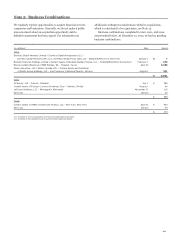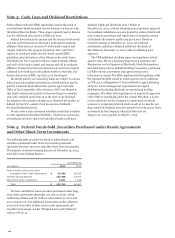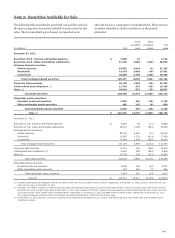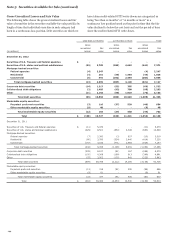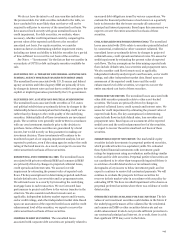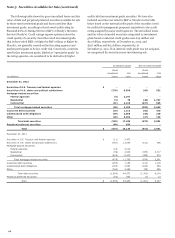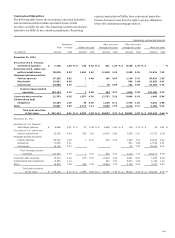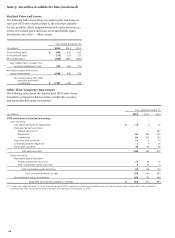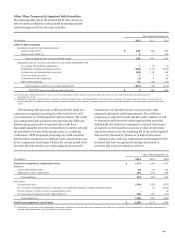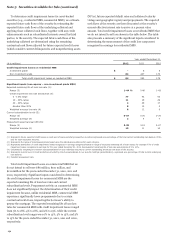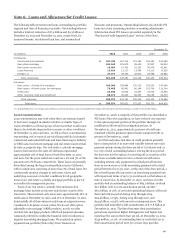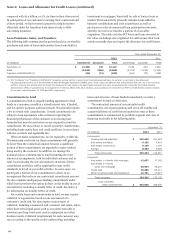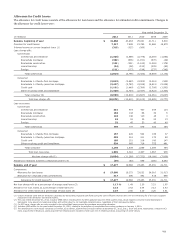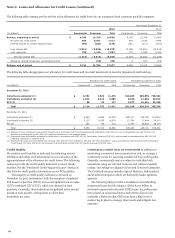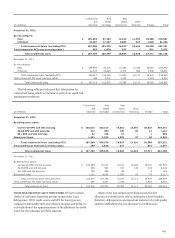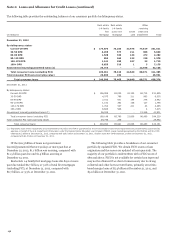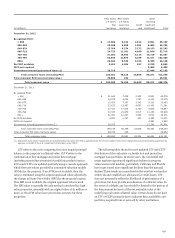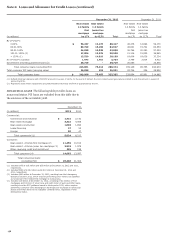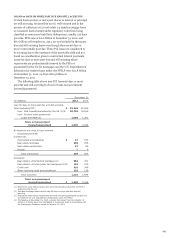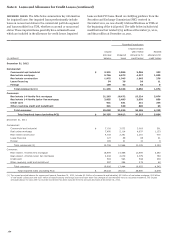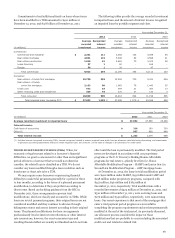Wells Fargo 2012 Annual Report Download - page 153
Download and view the complete annual report
Please find page 153 of the 2012 Wells Fargo annual report below. You can navigate through the pages in the report by either clicking on the pages listed below, or by using the keyword search tool below to find specific information within the annual report.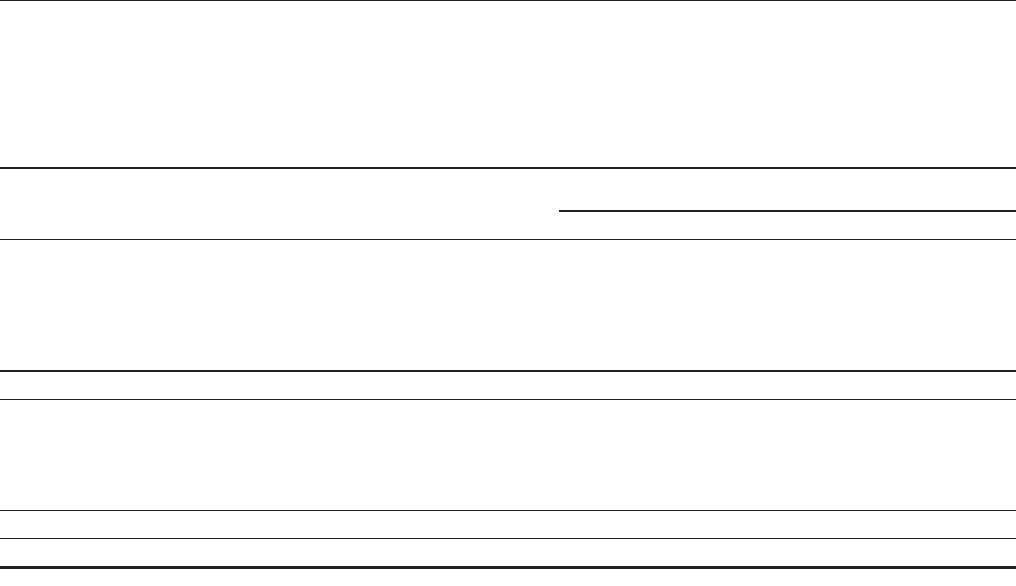
Note 6: Loans and Allowance for Credit Losses
The following table presents total loans outstanding by portfolio
segment and class of financing receivable. Outstanding balances
include a total net reduction of $7.4 billion and $9.3 billion at
December 31, 2012 and December 31, 2011, respectively, for
unearned income, net deferred loan fees, and unamortized
discounts and premiums. Outstanding balances also include PCI
loans net of any remaining purchase accounting adjustments.
Information about PCI loans is presented separately in the
“Purchased Credit-Impaired Loans” section of this Note.
December 31,
(in millions) 2012 2011 2010 2009 2008
Commercial:
Commercial and industrial $ 187,759 167,216 151,284 158,352 202,469
Real estate mortgage 106,340 105,975 99,435 97,527 94,923
Real estate construction 16,904 19,382 25,333 36,978 42,861
Lease financing 12,424 13,117 13,094 14,210 15,829
Foreign (1) 37,771 39,760 32,912 29,398 33,882
Total commercial 361,198 345,450 322,058 336,465 389,964
Consumer:
Real estate 1-4 family first mortgage 249,900 228,894 230,235 229,536 247,894
Real estate 1-4 family junior lien mortgage 75,465 85,991 96,149 103,708 110,164
Credit card 24,640 22,836 22,260 24,003 23,555
Other revolving credit and installment 88,371 86,460 86,565 89,058 93,253
Total consumer 438,376 424,181 435,209 446,305 474,866
Total loans $ 799,574 769,631 757,267 782,770 864,830
(1) Substantially all of our foreign loan portfolio is commercial loans. Loans are classified as foreign if the borrower’s primary address is outside of the United States.
Loan Concentrations
Loan concentrations may exist when there are amounts loaned
to borrowers engaged in similar activities or similar types of
loans extended to a diverse group of borrowers that would cause
them to be similarly impacted by economic or other conditions.
At December 31, 2012 and 2011, we did not have concentrations
representing 10% or more of our total loan portfolio in domestic
commercial and industrial loans and lease financing by industry
or CRE loans (real estate mortgage and real estate construction)
by state or property type. Our real estate 1-4 family mortgage
loans to borrowers in the state of California represented
approximately 13% of total loans at both December 31, 2012
and 2011. For the years ended 2012 and 2011, 2% and 3% of the
amounts were PCI loans, respectively. These loans are generally
diversified among the larger metropolitan areas in California,
with no single area consisting of more than 3% of total loans. We
continuously monitor changes in real estate values and
underlying economic or market conditions for all geographic
areas of our real estate 1-4 family mortgage portfolio as part of
our credit risk management process.
Some of our real estate 1-4 family first and junior lien
mortgage loans include an interest-only feature as part of the
loan terms. These interest-only loans were approximately 18% of
total loans at December 31, 2012, and 21% at December 31, 2011.
Substantially all of these interest-only loans at origination were
considered to be prime or near prime. We do not offer option
adjustable-rate mortgage (ARM) products, nor do we offer
variable-rate mortgage products with fixed payment amounts,
commonly referred to within the financial services industry as
negative amortizing mortgage loans. We acquired an option
payment loan portfolio (Pick-a-Pay) from Wachovia at
December 31, 2008. A majority of the portfolio was identified as
PCI loans. Since the acquisition, we have reduced our exposure
to the option payment portion of the portfolio through our
modification efforts and loss mitigation actions. At
December 31, 2012, approximately 4 percent of total loans
remained with the payment option feature compared with 10
percent at December 31, 2008.
Our first and junior lien lines of credit products generally
have a draw period of 10 years with variable interest rates and
payment options during the draw period of (1) interest only or
(2) 1.5% of total outstanding balance. During the draw period,
the borrower has the option of converting all or a portion of the
line from a variable interest rate to a fixed rate with terms
including interest-only payments for a fixed period between
three to seven years or a fully amortizing payment with a fixed
period between five to 30 years. At the end of the draw period, a
line of credit generally converts to an amortizing payment loan
with repayment terms of up to 30 years based on the balance at
time of conversion. At December 31, 2012, our lines of credit
portfolio had an outstanding balance of $84.6 billion, of which
$2.1 billion (2%) is in its amortization period, another
$8.2 billion, or 10%, of our total outstanding balance, will reach
their end of draw period during 2013 through 2014,
$29.4 billion, or 35%, during 2015 through 2017, and
$44.9 billion, or 53%, will convert in subsequent years. This
portfolio had unfunded credit commitments of $77.8 billion at
December 31, 2012. The lines that enter their amortization
period may experience higher delinquencies and higher loss
rates than the ones in their draw period. At December 31, 2012,
$223 million, or 11%, of outstanding lines of credit that are in
their amortization period were 30 or more days past due,
151


